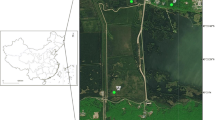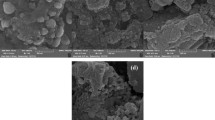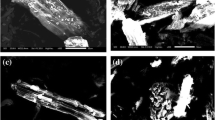Abstract
Metal mobility, bioavailability and potential toxicity in the soil are related to its concentration in soil solution, associated with organic and other solid phase. Therefore, metal fractionation needs to be given special attention. The objective of this study was to determine the chemical fractions of iron (Fe), as one of the most important essential nutrient element for plant species, in the soils of three land use types including agricultural, rangeland and forest as influenced by application of three levels (0, 1.5 and 3 wt%) of wheat straw- derived biochar through an incubation experiment. In all land uses without biochar application, the residual fraction was the dominant form while the carbonate fraction was the lowest. In the agricultural and rangeland soils after application of 1.5% biochar, the organic matter-bounded fraction was the maximum but it decreased after application of 3% biochar. The concentration of exchangeable-Fe fraction decreased significantly by nearly 51.9% and 63.68% with the application of 1.5 and 3% biochar as compared to that of control, respectively. The concentration of Fe associated with amorphous-Fe-oxide in the agricultural soils was higher than that of the other soils. The Fe residual fractions in the forest and rangeland soils were higher than that of the agricultural soils. Application of 3% biochar decreased the residual fractions, significantly (P < 0.05). In all treatments the mobility factor gave values not higher than 1%. Therefore Fe bioavailability was very low in the studied soils. There is a need to conduct more studies on soil heavy metal remediation by using organic substances such as biochar due to its potential to decrease the risk of environmental pollution.




Similar content being viewed by others
References
Karimi, R., Ayoubi, S., Jalalian, A., Sheikh-Hosseini, A.R., Afyuni, M.: Relationships between magnetic susceptibility and heavy metals in urban topsoils in the arid region of Isfahan, central Iran. J. Appl. Geophys. 74, 1–7 (2011)
Taghipour, M., Ayoubi, Sh, Khademi, H.: Contribution of lithologic and anthropogenic factors to surface soil heavy metals in western Iran using multivariate geostatistical analyses. Soil Sediment Contam 20, 921–937 (2011)
Dankoub, Z., Ayoubi, S., Khademi, H., Sheng-Gao, L.: Spatial distribution of magnetic properties and selected heavy metals in calcareous soils as affected by land use in the Isfahan region, Central Iran. Pedosphere 22, 33–47 (2012)
Naimi, S., Ayoubi, S.: Vertical and horizontal distribution of magnetic susceptibility and metal contents in an industrial district of central Iran. J. Appl. Geophys. 96, 55–66 (2013)
Ayoubi, Sh, Soltani, Z., Khademi, H.: Particle size distribution of heavy metals and magnetic susceptibility in an industrial site. Bull. Environ. Contam.Toxicol. 100, 708–714 (2018)
Tessier, A., Campbell, P.G.C., Bisson, M.: Sequential extraction procedure for the speciation of particulate trace metals. Anal. Chem. 51, 231–235 (1979)
Hass, A., Fine, P.: Sequential selective extraction procedures for the study of heavy metals in soils, sediments, and waste materials—a critical review. Crit Rev Environ. Sci. Technol. 40, 365–399 (2010)
Narwal, R.P., Singh, B.R., Salbu, B.: Association of cadmium, zinc, copper and nickel with components in naturally heavy metal-rich soils studied by parallel and sequential extractions. Commun. Soil Sci. Plant Anal. 30, 1209–1230 (1999)
Zahedifar, M., Moosavi, A.A.: Modeling desorption kinetics of the native and applied zinc in biochar-amended calcareous soils of different land uses. Environ. Earth Sci. 76, 1–11 (2017)
Zahedifar, M.: Sequential extraction of zinc in the soils of different land use types as influenced by wheat straw derived biochar. J. Geochem. Explor. 182, 22–31 (2017)
Baghernejad, M., Javaheri, F., Moosavi, A.A.: Adsorption isotherms of some heavy metal under conditions of their competitive adsorption onto highly calcareous soils of southern Iran. Arch. Agron. Soil Sci. 62, 1462–1473 (2016)
Baghernejad, M., Javaheri, F., Moosavi, A.A.: Adsorption isotherms of copper and zinc in clay minerals of calcareous soils and their effects on X-ray diffraction. Arch. Agron. Soil Sci. 61, 1061–1077 (2015)
Krishnamurti, G.S.R., Naidu, R.: Chemical speciation and bioavailability of trace metals. In: Violante, A., Huang, P.M., Gadd, G.M. (eds.) Biophysico-Chemical Processes of Heavy Metals and Metalloids in Soil Environments, pp. 419–466. Wiley Inter Science, New York (2008)
Bacon, J.R., Davidson, C.M.: Is there a future for sequential chemical extraction? Analyst 133, 25–46 (2008)
Gleyzes, C., Tellier, S., Astruc, M.: Fractionation studies of trace elements in contaminated soils and sediments: a review of sequential extraction procedures. Trends Anal. Chem. 21, 67–76 (2002)
Baeyens, W., Monteny, F., Leermakers, M., Bouillon, S.: Evaluation of sequential extractions on dry and wet sediments. Anal. Bioanal. Chem. 376, 890–901 (2003)
Ahnstrom, Z.S., Parker, D.R.: Development and assessment of a sequential extraction procedure for the fractionation of soil cadmium. Soil Sci. Soc. Am. J. 63, 1650–1658 (1999)
Beck, J.N., Gauthreaux, K., Sneddon, J.: Abstracts of Papers, 221st ACS National Meeting, San Diego, USA, 2001
Hall, G.E.M.P., Pelchat, P.: Comparability of results obtained by the use of different selective extraction schemer for the determination of element forms in soils. Water Air Soil Pollut. 112, 141–153 (1999)
Xing, G.X., Zhu, J.G.: Soil Chemistry of Trace Elements and Rare Earth Elements. Science Press, Beijing (2003)
Connolly, E.L., Guerinot, M.L.: Iron stress in plants. Genome Biol. 3, 1024.1–1024.4 (2002)
Krebs, R., Gupta, S.K., Furrer, G., Schulin, R.: Solubility and plant uptake of metals with and without liming of sludge-amended soils. J. Environ. Qual. 27, 18–23 (1998)
Jelic, M., Milivojevic, J., Trifunovic, S., Dalovic, I., Milosev, D., Seremesic, S.: Distributions and forms of iron in the vertisols of Serbia. J. Serb. Chem. Soc. 76, 781–794 (2011)
Matteson, G.C., Jenkins, B.M.: Food and processing residues in California: resource assessment and potential for power generation. Biores. Technol. 98, 3098–3105 (2007)
Lehman, J.: Bio-energy in the black. Front. Ecol. Environ. 5, 381–387 (2007)
Wang, Y., Zang, L., Yang, H., Yan, G., Xu, Z., Chen, C., Zhang, D.: Biochar nutrient availability rather than its water holding capacity governs the growth of both C3 and C4 plants. J. Soils Sediments 16, 801–810 (2016)
Gavili, E., Moosavi, A.A., Moradi Choghamarani, F.: Cattle manure biochar potential for ameliorating soil physical characteristics and spinach response under drought. Arch. Agron. Soil Sci. 64, 1714–1727 (2018)
Liu, L., Chena, H., Caia, P., Lianga, W., Huanga, Q.: Immobilization and phytotoxicity of Cd in contaminated soil amended with chicken manure compost. J. Hazard. Mater. 163, 563–567 (2009)
Beesley, L., Dickinson, N.: Carbon and trace element fluxes in the porewater of an urban soil following green waste compost, woody and biochar amendments, inoculated with the earthworm Lumbricus terrestris. Soil Biol. Biochem. 43, 188–196 (2011)
Beesley, L., Moreno-Jimenez, E., Gomez-Eyles, J.L.: Effects of biochar and green carpathian journal of earth and environmental sciencesamendments on mobility, bioavailability and toxicity of inorganic and organic contaminants in a multi-element polluted soil. Environ. Pollut. 158, 2282–2287 (2010)
Soil Survey Staff: Keys to Soil Taxonomy, 12th edn. USDA-Natural Resources Conservation Service, Washington, DC (2014)
Gee, G.W., Bauder, J.W.: Particle-size analysis. In: Klute, A. (ed.) Methods of Soil Analysis, Part 1. Physical and Mineralogical Methods. Agronomy Monograph No. 9, 2rd edn., pp. 383–411. American Society of Agronomy/Soil Science Society of America, Madison (1986)
Nelson, D.W., Sommers, L.E.: Total carbon, organic carbon and organic matter. In: Sparks, D.L. (ed.) Methods of Soil Analysis, Part III, 3rd edn., pp. 961–1010. American Society and Agronomy, Madison (1996)
Sumner, M.E., Miller, W.P.: Cation exchange capacity and exchange coefficients. In: Sparks, D.L. (ed.) Methods of Soil Analysis. Part 3. Chemical Methods. SSSA Book Ser. 5. SSSA and ASA, Madison (1996)
Loppert, R.H., Suarez, D.L.: Carbonate and gypsum. In: Sparks’s, D.L. (ed.) Methods of Soil Analysis, Part III, 3rd edn., pp. 437–474. American Society of Agronomy, Madison (1996)
Lindsay, W.L., Norvell, W.A.: Development of a DTPA soil test for zinc, iron, manganese, and copper. Soil Sci. Soc. Am. J. 42, 421–428 (1978)
Olsen, S.R.C., Cole, V., Watanable, F.S., Dean, L.A.: Estimation of available phosphorus in soil by extraction with sodium bicarbonate. In: USDA Circular, vol. 939. US Government Printing Office, Washington, DC (1954)
Bremner, J.M.: Nitrogen-total. In: Methods of Soil Analysis. Part 3. Chemical Methods. SSSA Book Series No. 5. (1996)
Singh, J.P., Karwasra, S.P.S., Singh, M.: Distribution and forms of copper, iron, manganese, and zinc in calcareous soils of India. Soil Sci. 146, 359–366 (1988)
Kabala, C., Singh, B.R.: Fractionation and mobility of copper, lead and zinc in soil profiles in vicinity of a copper smelter. J. Environ. Qual. 30, 485–492 (2001)
Han, F.X., Banin, A., Kingery, W.L., Triplett, G.B., Zhou, L.X., Zheng, S.J., Ding, W.X.: New approach to studies of heavy metal redistribution in soil. Adv. Environ. Res. 8, 113–120 (2003)
Yuan, C.G., Shi, J.B., He, B., Liu, J.F., Liang, L.N., et al.: Speciation of heavy metals in marine sediments from the East China Sea by ICP-MS with sequential extraction. Environ. Int. 30, 769–783 (2004)
Cuong, T.D., Obbard, J.P.: Metal speciation in coastal marine sediments from Singapore using a modified BCR-sequential extraction procedure. Appl. Geochem. 21, 1335–1346 (2006)
He, Q., Ren, Y., Mohamed, I., Ali, M., Hassan, W., Zeng, F.: Assessment of trace and heavy metal distribution by four sequential extraction procedures in a contaminated soils. Soil Water Res. 2, 71–76 (2013)
Zhang, M., Alva, K., Li, Y.C., Calvert, D.V.: Fractionation of iron, aluminum, and phosphorous in selected sandy soils under citrus production. Soil Sci. Soc. Am. J. 61, 797–801 (1997)
Park, J.H., Choppala, G.K., Bolan, N.S., Chung, J.W., Chuasavathi, T.: Biochar reduces the bioavailability and phytotoxicity of heavy metals. Plant Soil 348, 439–451 (2011)
Moral, R., Gilkes, R.J., Jordan, M.M.: Distribution of heavy metals in calcareous and noncalcareous soils in Spain. Water Air Soil Pollut. 162, 127–142 (2005)
Saha, J.K., Adhikari, T., Mandal, B.: Effect of lime and organic matter on distribution of zinc, copper, iron, and manganese in acid soils. Commun. Soil Sci. Plant Anal. 30, 1819–1829 (1999)
Sharma, B.D., Chahal, D.S., Singh, P.K., Raj-Kumar: Forms of iron and their association with soil properties in four soil taxonomic orders of arid and semi-arid soils of Punjab, India. Commun. Soil Sci. Plant Anal. 39, 2550–2567 (2008)
Lindsay, W.L.: Iron oxide solubilization by organic matter and its effect on iron availability. Plant Soil 130, 27–34 (1991)
Cao, X., Ma, L., Gao, B., Harris, L.: Dairy-manure derived biochar effectively sorbs lead and atrazine. Environ. Soil Technol. 43, 3285–3291 (2009)
Uchimiya, M., Lima, I.M., Klasson, T., Chang, S., Wartelle, L.H., Rodgers, J.E.: Immobilization of heavy metals ions (CuII, CdII, NiII and PbII) by broiler litter-derived biochars in water and soil. J. Agric. Food Chem. 58, 5538–5544 (2010)
Abd-Elfattah, A., Wada, K.: Adsorption of lead, copper, zinc, cobalt, and cadmium by soils that differ in cation exchange materials. Eur. J. Soil Sci. 32, 271–283 (1981)
Zahedifar, M., Dehghani, S., Moosavi, A.A., Gavili, E.: Temporal variation of total and DTPA-extractable heavy metal contents as influenced by sewage sludge and perlite in a calcareous soil. Arch. Agron. 63, 136–149 (2017)
Moosavi, A.A., Dehghani, S., Sameni, A.: Spatial Variability of Plant-available Micronutrients in the Surface and Subsurface Layers of a Calcareous Soil. Thai J. Agric. Sci. 48, 165–178 (2015)
Acknowledgements
The authors acknowledge financial support from the Fasa University, Fasa, IR Iran.
Author information
Authors and Affiliations
Corresponding author
Rights and permissions
About this article
Cite this article
Zahedifar, M. Iron Fractionation in the Calcareous Soils of Different Land Uses as Influenced by Biochar. Waste Biomass Valor 11, 2321–2330 (2020). https://doi.org/10.1007/s12649-018-0481-9
Received:
Accepted:
Published:
Issue Date:
DOI: https://doi.org/10.1007/s12649-018-0481-9




